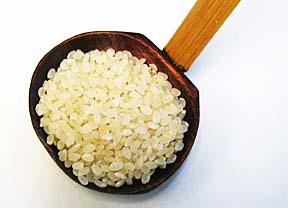

Key Ingredient

|
Key ingredient: haiga rice
It's neither brown nor white rice, but a rice that's in between. Haiga is a new form of rice that up until about a year ago was available only in Japan. With haiga, the rice bran is meticulously removed, leaving the nutritious rice germ still attached to the kernel. It's being touted as a healthy alternative to white rice minus the tough bran fiber of brown rice.The basics: Haiga is not a variety of rice, but rather the result of a particular milling process. The name haiga, which means embryo or bud in Japanese, refers to the rice germ. The rice itself is a premium-grade short-grain rice.
The milling process was developed in Japan sometime before World War II in response to a severe vitamin B deficiency in the Japanese diet, resulting in an outbreak of beriberi disease -- a condition that affects the heart and nervous system. By keeping the rice germ, crucial vitamins and nutrients were also retained.
Milling technology has since vastly improved, allowing for mass production of the rice. Still, removing just the bran is a tedious and time-consuming process. Ordinary white rice goes through a milling process only once, while haiga is milled about eight times to carefully remove the bran layer by layer without disturbing the germ. The result is a glossy, semi-transparent rice with a hint of beige.
The rice is similar in taste to white rice with a slightly sweet, nutty flavor. Haiga is a good source of vitamins B, E and C.
Selecting: A handful of rice companies are starting to produce haiga, but the brand readily available here is Tamaki Haiga. Masami Kitagawa, president of Williams Rice Milling Co. in Sacramento and producer of Tamaki Haiga, suggests that it be bought in small quantities and used quickly because it oxidizes and deteriorates faster than white rice.
Tamaki Haiga is first packaged in an airtight plastic bag, then placed in a brown paper bag to limit exposure to light. Purchase new-crop rice whenever possible.
Storing: Like all rice, keep haiga in a cool, dark area, preferably in an airtight container.
Use: Haiga cooks with the same amount of water and in the same amount of time as white rice. Rinse gently, and only a couple of times, so as not to disturb the fragile germ.
Where to buy: Haiga can be found at markets such as Daiei and Marukai. The price is pretty steep at $7 to $9 for a 5-pound bag, but worth every penny.
Food Stuffs: Morsels
Eleanor Nakama-Mitsunaga is
a free-lance food writer. Contact her
online through features@starbulletin.com